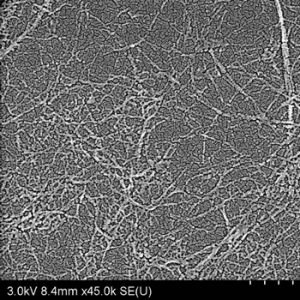Dec 10 2014
Researchers from Sappi and Edinburgh Napier University have come up with an economical technique to convert wood into nanocellulose, which could be used for designing eco-friendly cars, for food thickening and for treating wounds.
 Nano-fibrils from the new process
Nano-fibrils from the new process
This implies that Sappi will produce this wonder material, nanocellulose in a commercially viable manner, thus avoiding huge quantities of chemical waste water related with presently available techniques. Sappi will construct a new nanocellulose producing pilot plant and use this energy-saving technique.
Math Jennekens, Project coordinator and R&D Director at Sappi Europe stated that “Nanocellulose, extracted from wood fibres, has a number of unique optical, barrier and strength properties. Unlike other lightweight, high-strength materials based on fossil fuels it is completely sustainable, making it very desirable as a new material for various industrial and transport applications.”
This multipurpose material has been produced previously by processing wood pulp intensively to release nano or ultra-small cellulose fibers – each so tiny that 2000 of them could be fitted in the width of one strand of human hair.
However, the Edinburgh Napier research team stated that they could considerably bring down the amount of energy required to power the process and also the need for costly chemicals.
“What is significant about our process is the use of unique chemistry which has allowed us to very easily break down the wood pulp fibers into nanocellulose,” said Professor Rob English, who headed the research along with Dr. Rhodri Williams, his Edinburgh Napier colleague.
“There is no expensive chemistry required and, most significantly, the chemicals used can be easily recycled and reused without generating large quantities of waste water. It produces a dry powder that can be readily redispersed in water and leaves the nanocellulose unmodified – effectively making its surface a chemical “blank canvas” and so more easily combined with other materials. The ability to bring all these attributes together have so far eluded materials scientists working in the field. It is very exciting.”
Professor English stated that nanocellulose, which will be produced at the planned Sappi plant can be used in a number of regularly used products and industrial devices as they can enhance material properties with which they are combined.
“It could be used to thicken water-based products such as paints, foods and concrete,” he said. “Or when it’s used in plastics to make a composite it can replace glass fibers, which is very attractive in the production of the next generation of lighter, fuel-efficient vehicles.
“Because of its low oxygen permeability it could also be a possible replacement for plastic films in packaging. Then there are also applications for it in containing films in lithium batteries and touch screen displays. And as cellulose is inherently bio-compatible and bio-absorbable, there is considerable potential in biomedical applications such as wound dressings and regenerative medicine.”
Andrea Rossi, Group Head Technology, Sappi Limited, stated that a pilot plant has been proposed “towards the end of 2015. This pilot plant” he continued “will move Sappi into new adjacent business fields based on renewable raw materials to produce innovative performance materials and help in delivering on Sappi's strategy to seek growth opportunities in adjacent and new markets.”
Professor English also said “Commercial interest in nanocellulose is growing at a phenomenal rate following predictions of a possible 35 million tonnes per year market by the 2020s. And so the key challenge now is very much in business development and understanding the value offered by nanocellulose in our target markets.”
Andrea Rossi stated that the pilot plant will test the production of dry re-dispersible Cellulose NanoFibrils (CNF). With the aid of this proprietary break-through technology, Sappi can produce CNF with distinct morphology modified specifically for hydrophilic or hydrophobic applications.
Products manufactured with be suited for conversion in strong and light fibre-reinforced plastics and composites, in pharmaceutical and food applications, in barrier, paper, coating applications and also in rheology modifiers.
According to Andrea Rossi, by using the products produced in the pilot-scale plant, Sappi will seek combined development with a number of partners to include CNF in a large range of product applications to create innovative characteristics and to optimise performance.